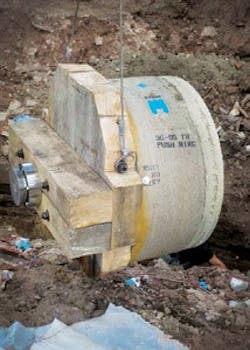About the author: Kimberly Paggioli is vice president of marketing for Hobas Pipe U.S.A. Paggioli can be reached at [email protected] or 281.821.2200.
The city of Niagara Falls, N.Y., is located on the Niagara River, across from the city of Niagara Falls, Ontario, Canada, and named for the famed Niagara Falls they share. Water and sewer services within Niagara Falls, N.Y., and adjoining areas are provided by the Niagara Falls Water Board (NFWB), which serves 50,000 people through more than 16,000 accounts, including residents, businesses and industrial facilities. Its vision is specific: “to become a first-class competitive utility in the next five to seven years.” NFWB has a strategy to get itself there, including continually investing in infrastructure to maintain facilities while economically providing customer service. This is exactly what spurred the recent Iroquois Street sewer lining project.
Outdated Infrastructure
Segmental block pipe came into use in the early 1900s and was used until the 1930s, when precast pipe became more readily available. The original Iroquois Street sewer was built in 1917 and utilized segmented block to construct the 54-in.-diameter sewer.
In the late 1980s, NFWB began a series of projects aimed at reducing significant groundwater infiltration in this portion of its service area. The projects included downstage and chemical grouting, internal and external pipe seals and flow rerouting. In the early 2010s, sewer flows were again rerouted to abandon and seal off the most heavily damaged and leaking section of the sewer.
The past repairs on sewer and tunnels provided some benefits. However, the Iroquois Street sewer recently was found to have serious structural problems in addition to significant groundwater infiltration, estimated at about 5 million gal per day. In the spring of 2013, an investigation into the problems and evaluation of corrective alternatives commenced. The specific stretch of sewer under investigation was the 2,200 ft from Buffalo Avenue to the Southside Interceptor.
“What was first thought to be an infiltration problem evolved to include serious sewer structural and longevity concerns,” said John Goeddertz, senior project manager for AECOM.
“Due to the depth of the sewer and the presence of underground utilities associated with both a nearby chemical plant and an electrical substation, a minimal amount of excavation was preferable,” Goeddertz said. “The industrial nature of the surrounding land and interfering utilities favored a sliplining approach for sewer rehabilitation. The specifications were written around sliplining the sewer and connecting tunnel with a small variety of acceptable liners.”
It was determined that a 36-in.-inside-diameter liner pipe was suitable for conveying the anticipated sewage flow.
Material Options
The contract documents allowed the use of three pipe materials, including fusion-welded high-density polyethylene, fusion-welded PVC or centrifugally cast fiberglass-reinforced polymer mortar (Hobas). The Hobas pipe was the only gasket-sealed pipe allowed because it was the only one that could withstand the potential compressive forces needed to push 1,500 ft of pipe from a single push pit. One push pit was specified to minimize the potential for uncovering contaminated soils while excavating.
Yarussi Construction of Niagara Falls, N.Y., was awarded the project and chose to utilize Hobas pipe for the installation. “The overall cost of using Hobas with the segmental joints was less expensive as a total installed cost,” said Camil Pachucki, estimator and project manager for Yarussi.
As part of the sewer cleaning operation, intermediate manholes were excavated and a mandrel was pulled to verify proper clearance for liner insertion. “We shipped all of the pipe from Houston, Texas, to Niagara Falls via truck within a week’s time in September of 2015,” said Rob Epstein, commercial manager for Hobas Pipe U.S.A. in Houston.
Once the host pipe was prepared, Yarussi sliplined 80% of the length in three days from a single push pit, inserting liner pipe in both directions. In all, 1,175 ft of the segmented block sewer were cleaned and lined. There were two separate lining operations, one proceeding southward from the push pit and one proceeding northward. The southward lining operation pushed approximately 900 ft of pipe, with about 300 ft installed to the north. The stretch was completed by open-cut methods into the rock tunnel section, again using Hobas pipe.
“We were able to easily install all the sliplining pipe from one pit and, as a requirement of the specifications, we used a load cell on the push frame and it recorded the load on the pipe. We pushed the pipe in with flow, and it slid in very well,” Pachucki said.
The recorded loads increased consistently as subsequent segmental pipe was added to the line. The maximum load on the northward run was approximately 10,000 lb, and roughly 21,000 lb for the southward section. The calculated friction factor for the two runs was 0.21 and 0.45, respectively. “This value is very typical of what is reported in Hobas sliplining installations,” said Rene Garcia, engineering supervisor for Hobas.
“The principal goal of the project was to reduce inflow and infiltration, and the results have been promising, reducing chemical usage and pumping costs at the treatment plant while also reducing wet-weather combined sewer overflow,” said Richard Roll, technical services director for NFWB. “In addition, an old sewer in the process of failing has been replaced with one expected to provide many decades of reliable service.”
Download: Here
